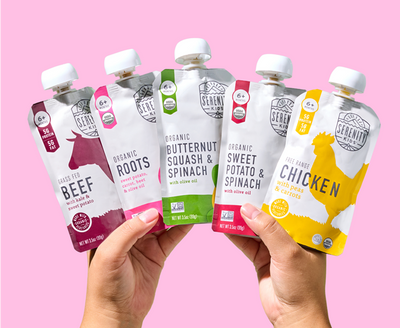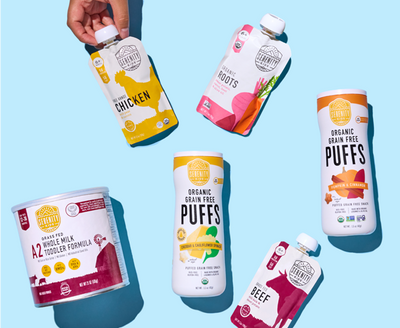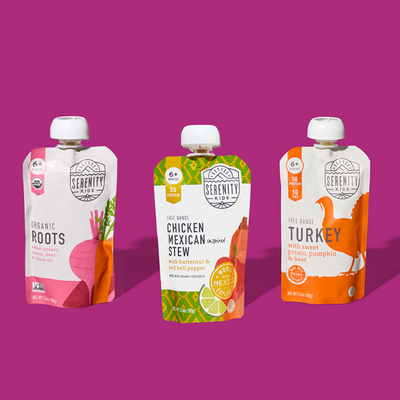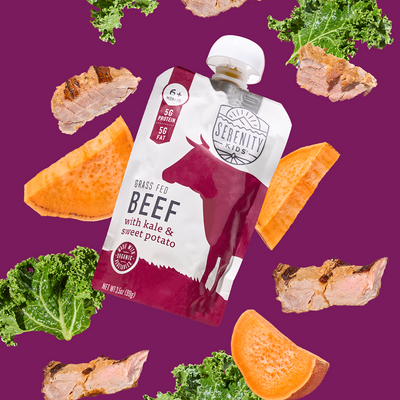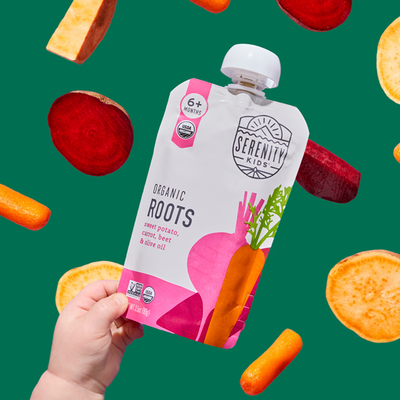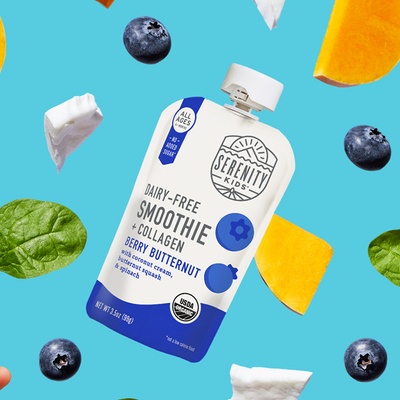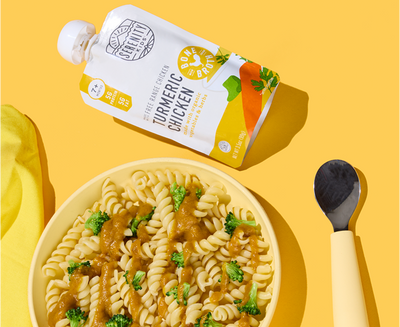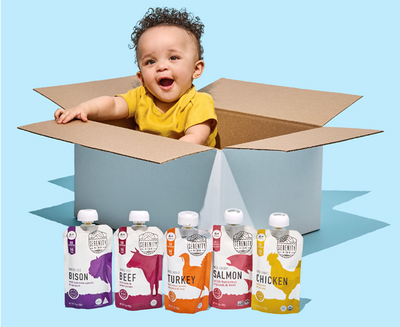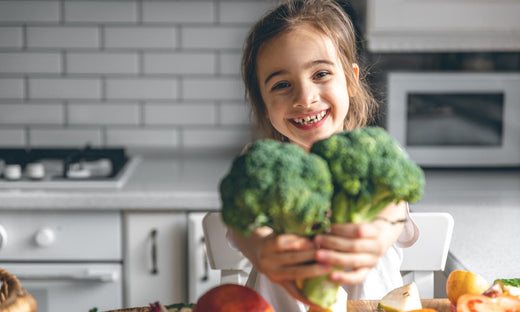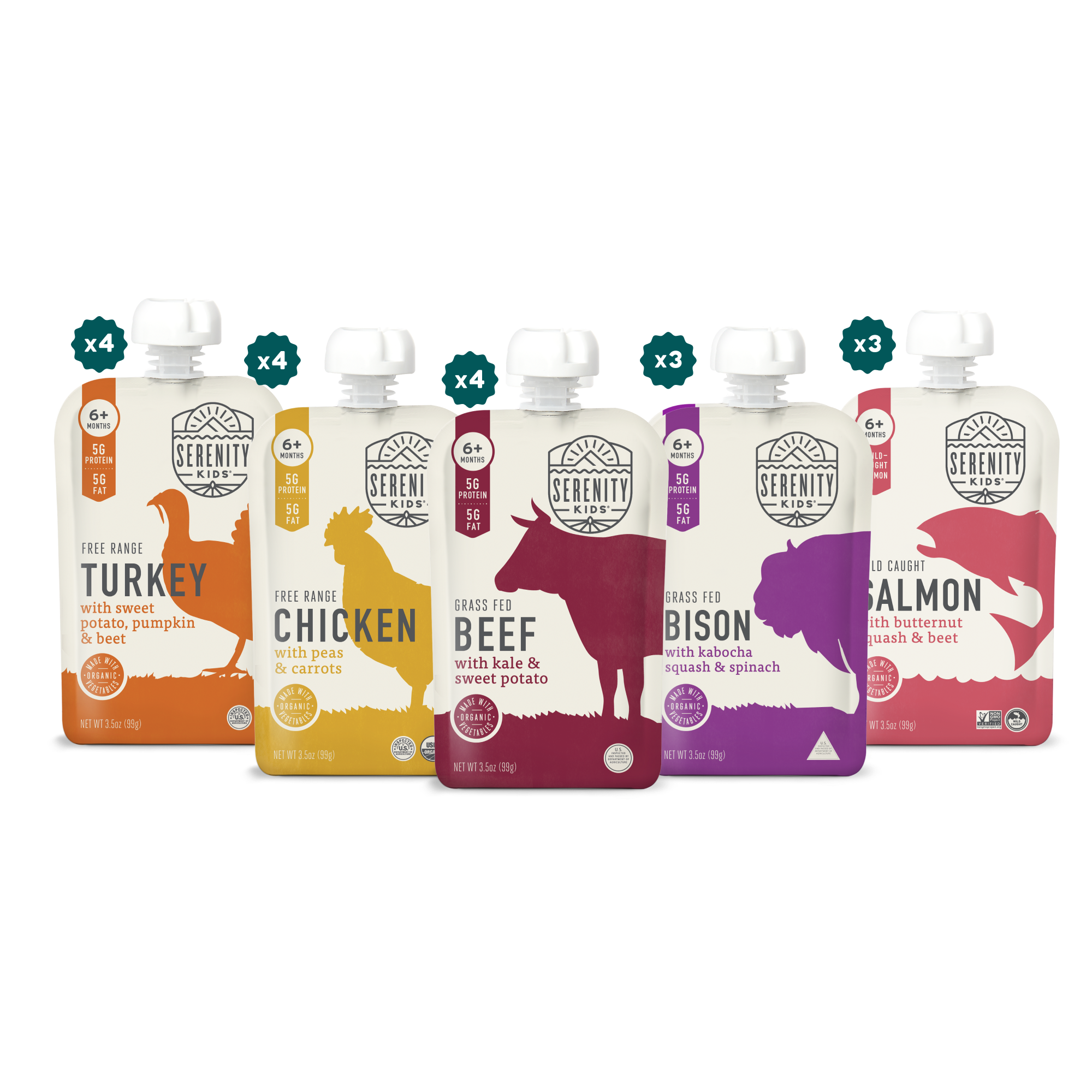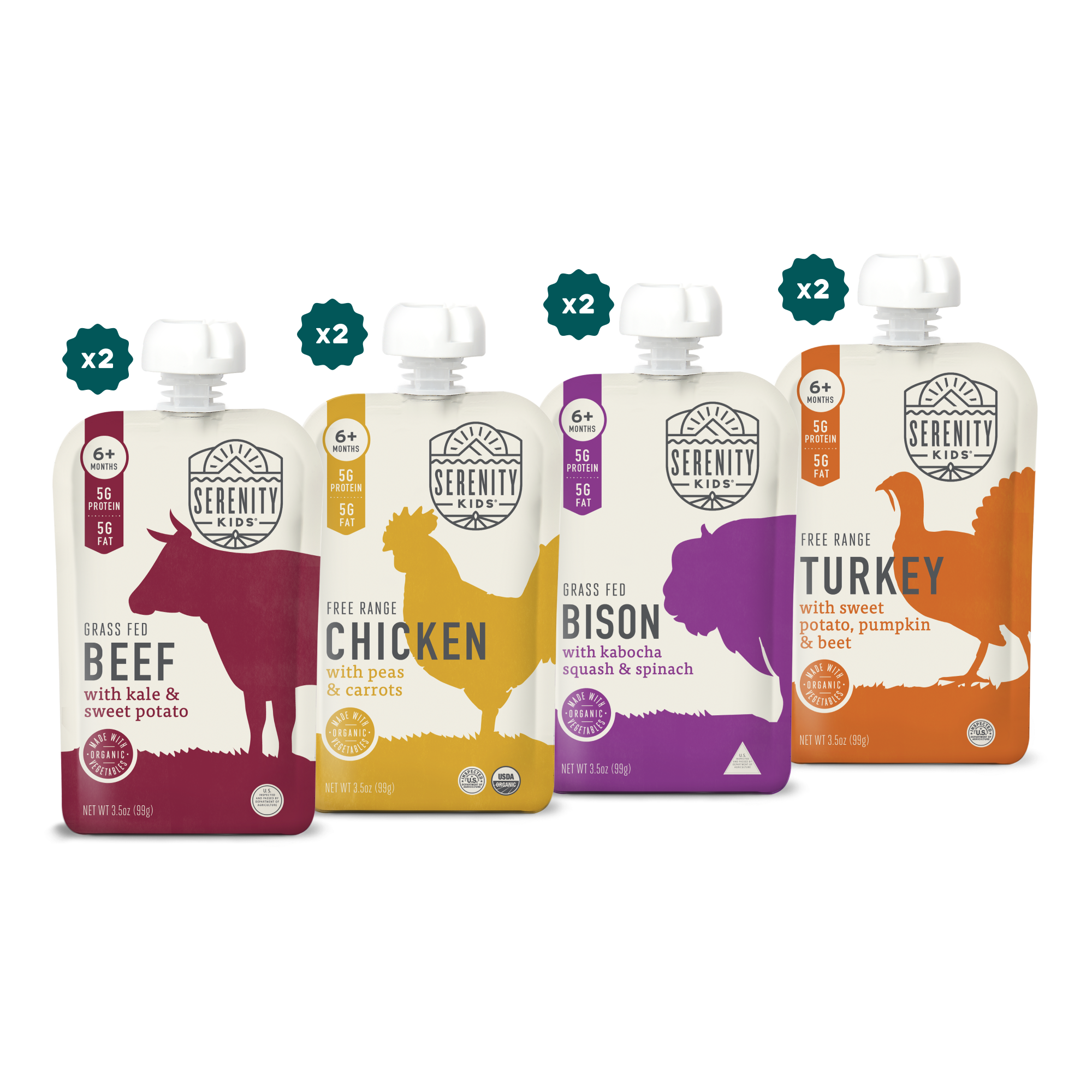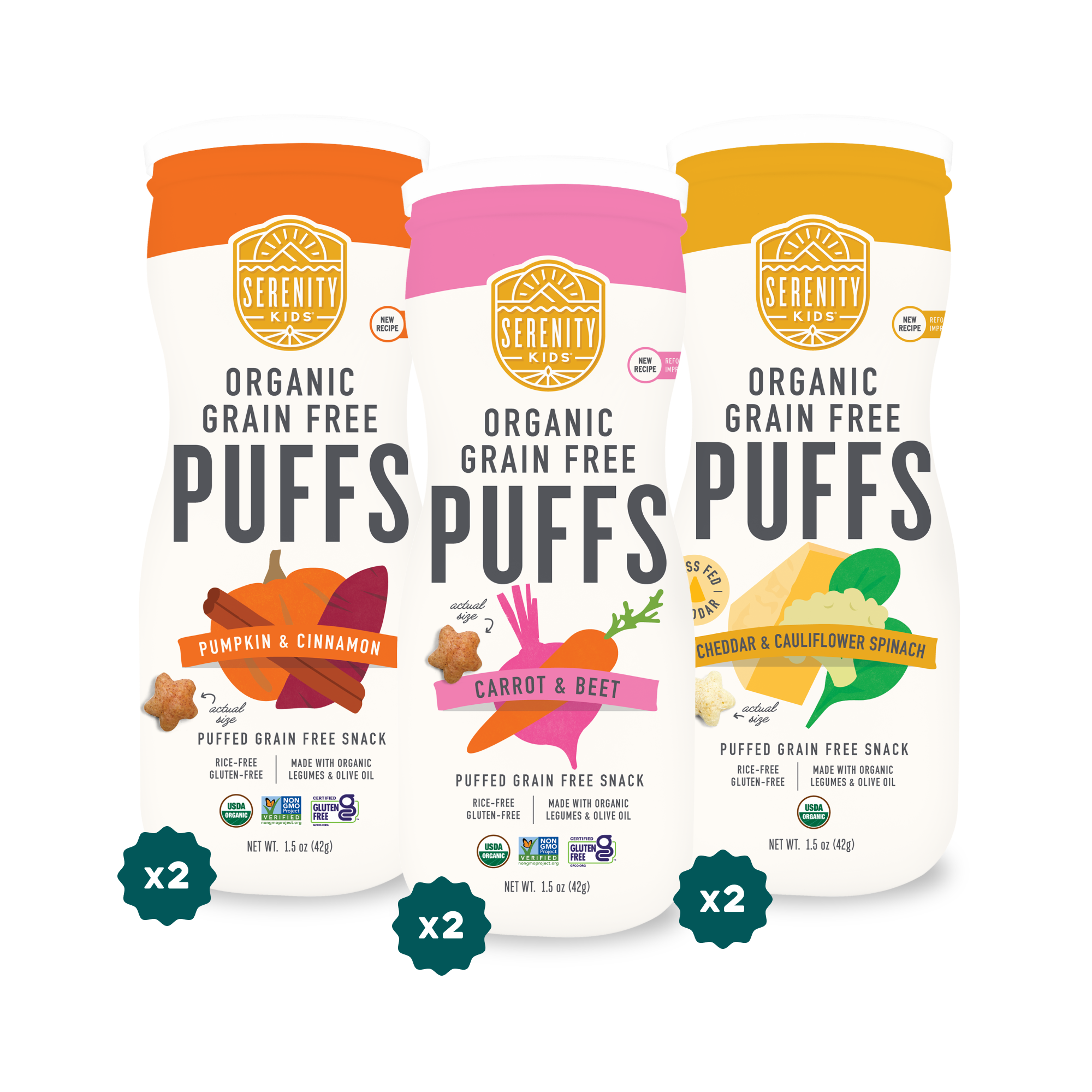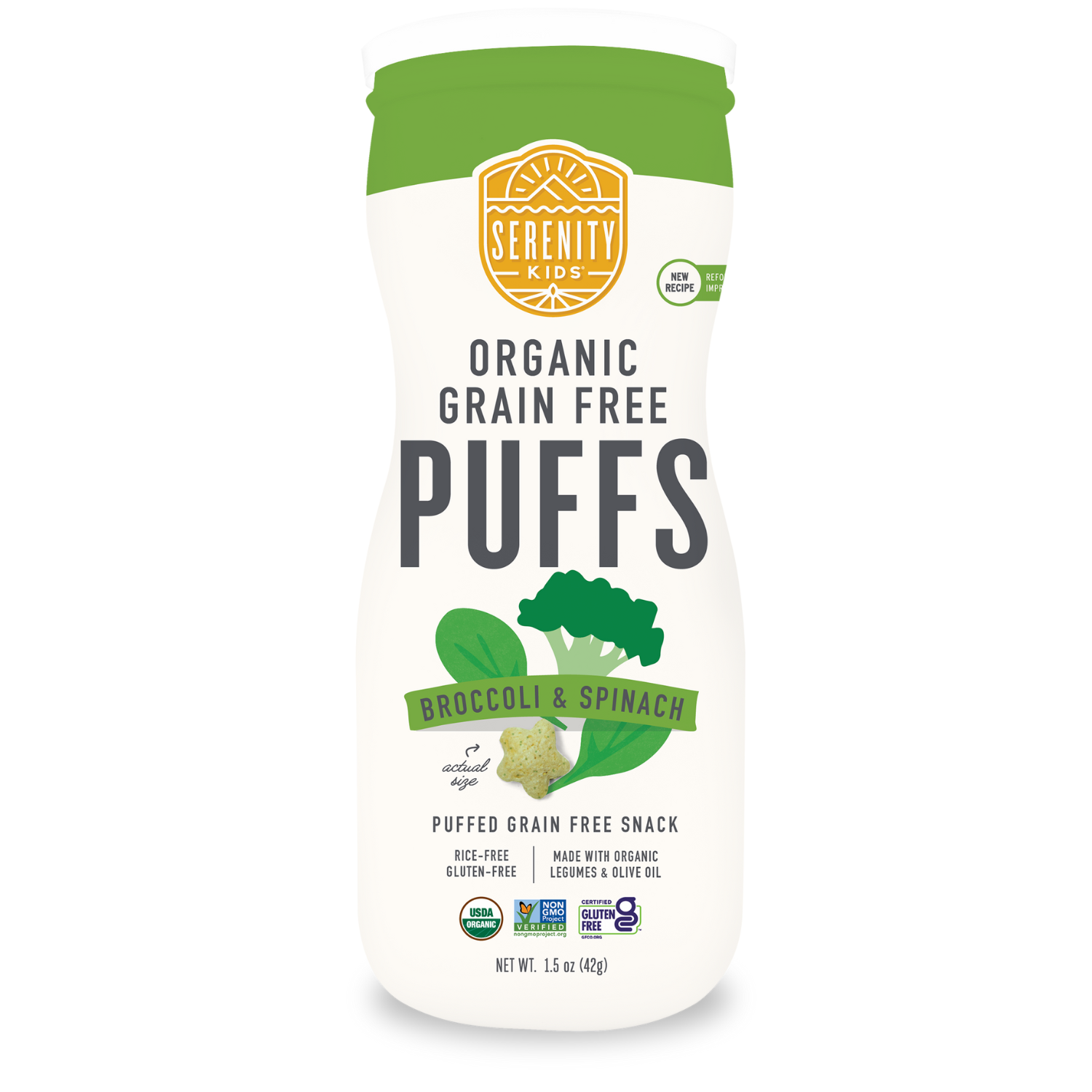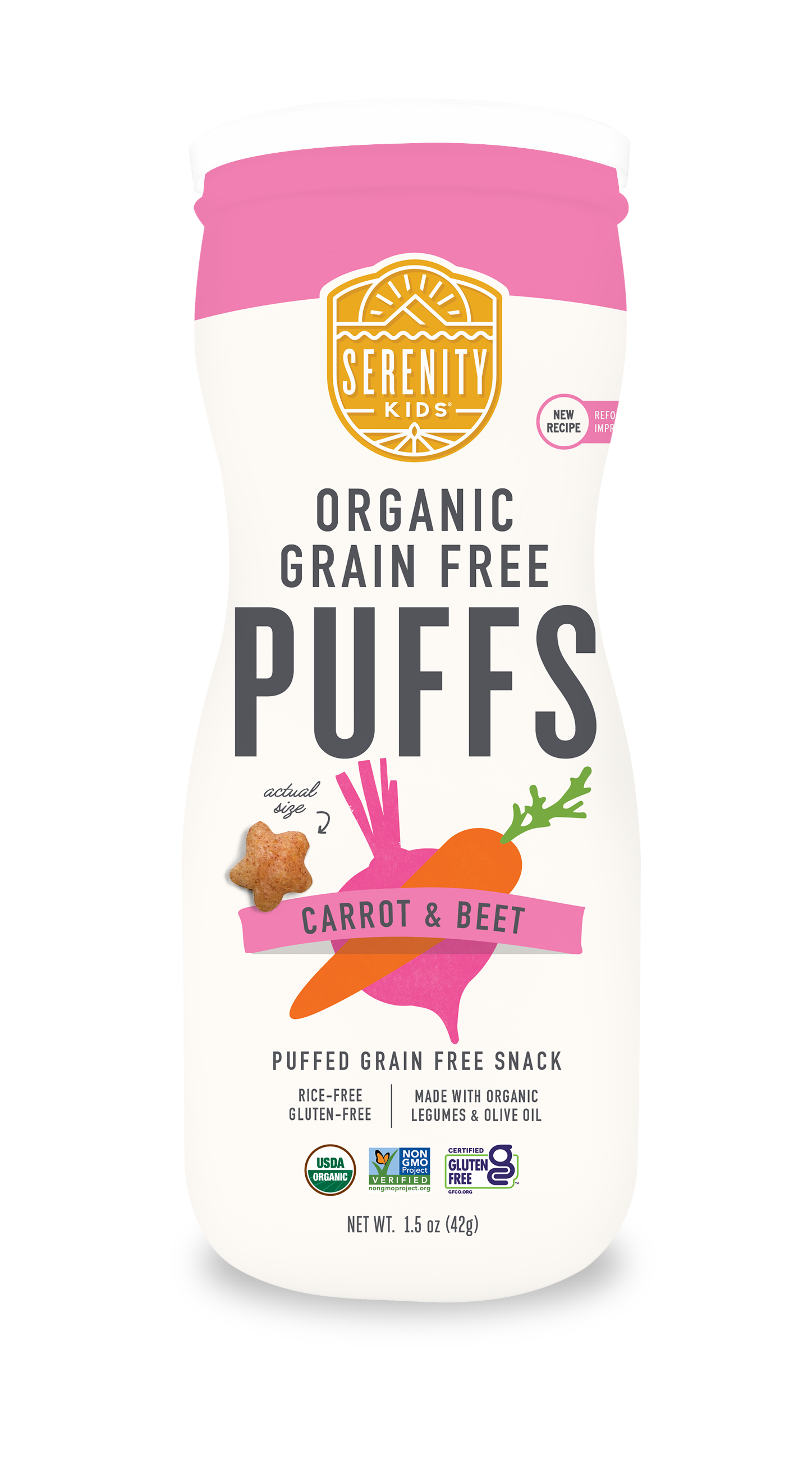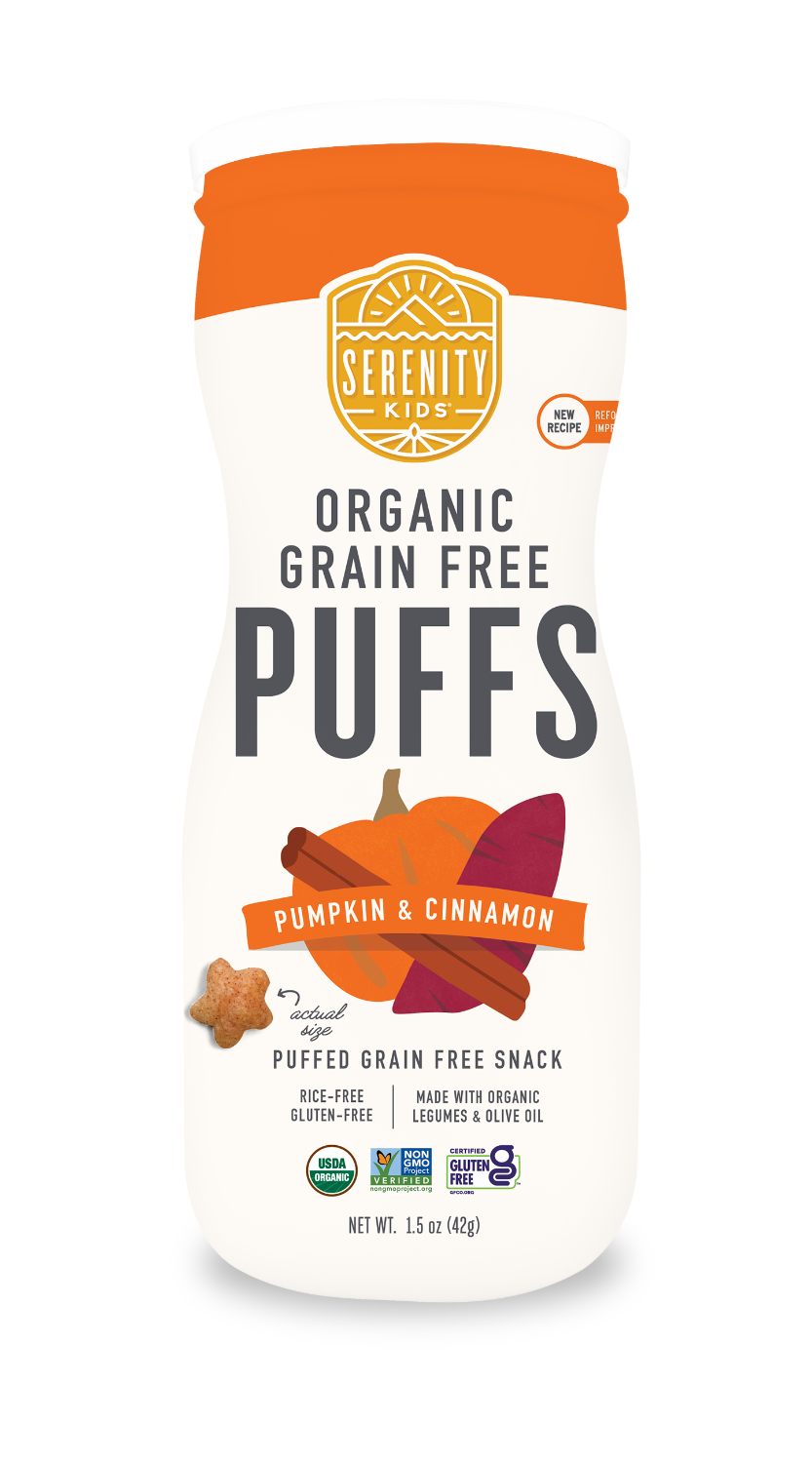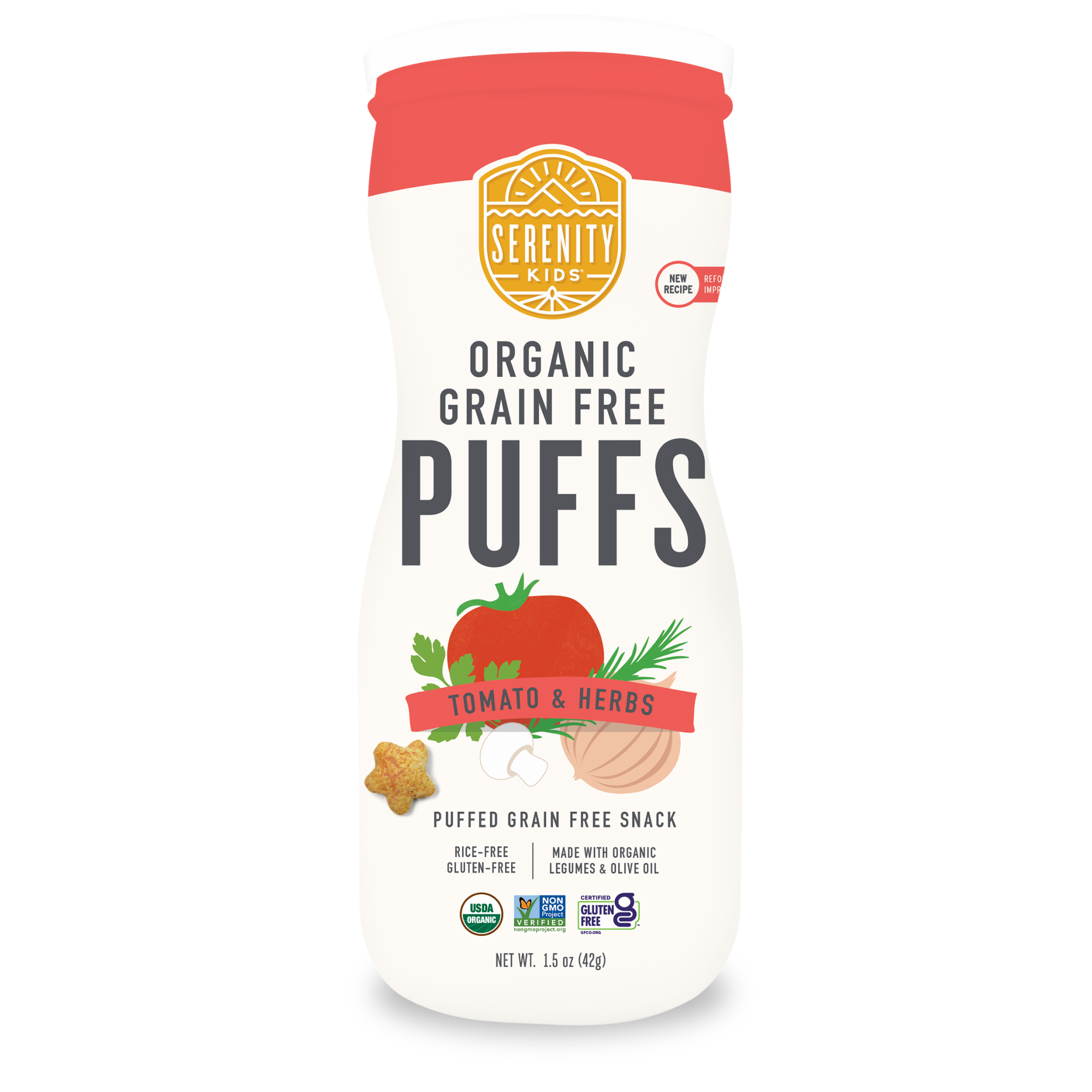As a new parent, you're likely overwhelmed by the countless decisions you need to make for your baby, from what clothes they should wear to the best ways to soothe them when they cry. What to feed your little one is one of the most important decisions because it lays the foundation for long-term health and well-being. A balanced diet, with all of the important components like protein and vegetables, provides vital nutrients that support everything from brain development to a strong immune system.
But let’s face it—getting your baby to eat and enjoy vegetables isn’t always easy. The good news is that with a bit of strategy and a lot of patience, you can encourage your child to embrace veggies from the very start. And when it comes to making healthy eating easier, Serenity Kids is passionate about supporting kids and parents with their organic, veggie-rich food pouches that are ready to eat and shelf-stable.
This blog post is your friendly guide on how to incorporate more vegetables into your baby’s diet right from the start. We’ll explore everything from understanding the importance of the flavor window to offering practical tips for introducing vegetables early and keeping your child’s palate on track.
What is the Flavor Window?
The flavor window is a crucial period in early childhood, typically from around six to 18 months, when babies are most open to trying new foods and flavors. During this phase, their taste preferences are not yet firmly established, making it an ideal time to introduce a variety of vegetables into their diet. The more diverse the flavors you offer during this window, the more likely your child is to develop a taste for a wide range of foods, including vegetables.
Veggie Nutrition Basics for New Parents
When it comes to feeding your baby, understanding the nutritional value of the foods you’re offering is crucial. Vegetables are packed with essential vitamins, minerals, and fiber that are vital for your baby’s growth and development.
Vegetables are nutritional powerhouses. They’re rich in vitamins like A, C, and K, which are essential for eye health, immune function, and blood clotting. They also provide minerals such as potassium and magnesium, which support healthy muscle function and bone development. Fiber, another critical component found in vegetables, aids in digestion and helps with satiety.
For instance, dark leafy greens like spinach and kale are high in iron and calcium, while orange vegetables like carrots and sweet potatoes provide beta-carotene, which supports healthy vision and immune function. Cruciferous vegetables like broccoli and cauliflower are packed with vitamins C and K, along with fiber and folate, which are vital for brain development.
By rotating the types of vegetables you offer, you can feel good that your baby is receiving a well-rounded intake of vitamins, minerals, and fiber. This variety also helps prevent mealtime boredom and keeps your baby engaged with new tastes, textures, and colors.
Avoiding Processed Sugars and Snacks
In today’s world, it’s all too easy to reach for convenient, processed snacks that are often high in sugar and low in nutrients. While these might seem like an easy option, especially when you’re a busy parent, they can negatively impact your baby’s developing taste preferences.
Introducing processed sugars and snacks too early can sabotage your child’s taste preferences, making it much harder to get them to enjoy vegetables. Sugary foods are highly palatable and addictive, and can quickly become preferred over more nutritious options like vegetables. This preference can be hard to reverse once established, leading to a cycle where your child consistently chooses sweet, less nutritious foods over healthier options.
Additionally, many processed snacks contain additives and preservatives. These foods often lack the essential nutrients found in whole, unprocessed foods, meaning they fill your baby up without providing the vitamins and minerals they need.
Choosing Whole Foods
Instead of reaching for processed snacks, focus on whole foods that are minimally processed and free from added sugars and artificial ingredients. Whole foods provide your baby with the nutrients they need to grow and thrive while helping to develop a natural preference for healthy options like vegetables.
For example, offering your baby a piece of avocado or a few steamed carrot sticks as a snack is a far better choice than a highly-processed option. Not only are you providing essential nutrients and extra veggies, but you’re also helping your child develop a taste for real, whole foods.
Reading Labels
As a new parent, you might not have a lot of time to scrutinize every food label, but it’s important to be aware of what’s in the foods you’re offering your baby. Processed foods often contain hidden sugars and unhealthy additives that can negatively impact your child’s health and taste preferences.
When choosing packaged foods, look for options with short ingredient lists, and make sure you recognize each ingredient. Avoid products with added sugars, artificial flavors, and preservatives. If you’re unsure, a good rule of thumb is to choose foods that are as close to their natural state as possible.
Tips for Introducing Vegetables Early
Now that you understand the importance of vegetables in your baby’s diet and the disadvantages of processed foods, let’s talk about some practical tips for introducing vegetables early and making them a regular part of your child’s meals.
Start Simple
When you first introduce vegetables to your baby, start with simple, mild options. Vegetables like pureed sweet potatoes, carrots, and butternut squash, are great first choices because they’re naturally sweet and have a smooth texture that most babies find appealing.
You can steam or roast these vegetables until they’re soft and then puree them in a food processor for easy eating. Adding a healthy fat can also improve flavor. As your baby gets used to these fresh veggies and new flavors, you can gradually introduce more variety, including slightly more bitter vegetables like peas, green beans, broccoli, and spinach.
Incorporating Vegetables into Everyday Meals
One of the best ways to ensure your baby is eating enough vegetables is to incorporate them into everyday meals. This can be as simple as mixing a spoonful of vegetable puree into their yogurt or adding finely chopped vegetables to their scrambled eggs.
For older babies who are starting to eat finger foods, you can offer steamed or roasted vegetable sticks that they can hold and explore. You can also blend vegetables into tomato sauce, vegetable soup, or even smoothies for a fun and nutritious twist.
Role Modeling
Babies are incredibly observant and often mimic the behaviors of the adults around them. By eating vegetables yourself and making them a regular part of your meals, you’re setting a positive example for your baby. When they see you enjoying vegetables, they’re more likely to be curious and want to try them too.
Make mealtime a family affair where everyone sits down together and eats the same foods, including vegetables. This not only reinforces the importance of vegetables in your child’s diet but also creates a positive, communal eating experience that can help reduce mealtime stress.
Making Vegetables Fun and Appealing
Getting your baby to eat vegetables isn’t always easy, especially if they’re going through a picky phase. But with a little creativity, you can make vegetables fun and appealing.
Creative Presentation
Sometimes (if you’re lucky), all it takes to get your baby to eat more veggies is a little creativity in how you present them. You can arrange colorful vegetables into fun shapes or patterns on their plate, like a rainbow or a smiley face. The visual appeal can make the meal more exciting and encourage your baby to try new things.
You can also use cookie cutters to create fun shapes out of steamed vegetables, making them more visually appealing and easier for little hands to pick up. Remember, eating is a sensory experience, and making food look good is just as important as making it taste good.
Flavor Enhancements
While it’s important to introduce your baby to the natural flavors of vegetables, sometimes a little flavor enhancement can go a long way in making them more appealing. You can add a pinch of mild herbs like fresh basil or parsley to give frozen vegetables a bit of extra flavor without overwhelming your baby’s palate. A drizzle of olive oil or a sprinkle of cheese can also add richness and depth to the vegetables, making them more enjoyable for your little one.
Another way to enhance flavor is by pairing vegetables with something your baby already likes. For instance, you can mix a small amount of mashed sweet potato with a fruit puree your baby enjoys, gradually increasing the ratio of vegetables to fruit as they become more accustomed to the taste.
Offer a Variety of Textures
Babies are naturally curious and love to explore different textures. Offering vegetables in a variety of textures can keep things interesting and help your baby develop a more diverse palate and increase their vegetable intake. For example, you can offer steamed vegetables that are soft and easy to chew, or roasted vegetables that have a slightly crispy exterior. Spaghetti squash can be a great substitute for white pasta, with some mild marinara sauce poured over the top.
As your baby gets older and more comfortable with eating, you can start introducing raw vegetables in small, manageable pieces. This not only adds a new texture to their meals but also provides them with an opportunity to practice their chewing skills.
Involve Your Baby in the Process
Even though your baby might be too young to fully participate in meal preparation, involving them in the process can make them more interested in eating vegetables. You can let them watch you as you wash, peel, and chop the vegetables, explaining what you’re doing and why. As they get older, you can give them small tasks like stirring or adding ingredients, which helps them feel involved and connected to the food they’re eating.
Navigating Picky Eating Phases
Almost every parent will face a phase where their baby becomes a picky eater. This can be a challenging time, but it’s important not to get discouraged. With patience and persistence, you can help your baby move past this phase and continue to enjoy a wide variety of vegetables.
Stay Consistent
One of the most important things you can do during a picky eating phase is to stay consistent. Continue to offer vegetables at every meal, even if your baby refuses them. Research shows that it can take multiple exposures—sometimes 10 or more—before a baby will accept a new food. The key is to keep trying without pressuring your baby to eat.
If your baby consistently refuses a particular vegetable, try offering it in a different form or paired with a food they already like. For example, if they don’t like steamed broccoli, try roasting it with a bit of olive oil or mixing it into a cheesy lentil pasta dish. Bell peppers are great dipped in hummus or some organic ranch dressing. The goal is to keep vegetables a regular part of their diet, even if they’re not eating large amounts at first.
Avoid Using Food as a Reward or Punishment
It can be tempting to use dessert or a favorite snack as a reward for eating vegetables, but this can create an unhealthy relationship with food. When food is used as a reward or punishment, it can lead to a preference for the “reward” food (often sweets) and a negative association with the “required” food (often vegetables).
Instead, try to keep mealtimes positive and low-pressure. Encourage your baby to try new foods, but don’t force them to eat something they don’t want. Praise their efforts to try new things, even if they only take a small bite. Over time, this approach can help your baby develop a healthy relationship with food and a more adventurous palate.
Make Mealtime Enjoyable
Creating a positive mealtime environment can make a big difference in how your baby perceives food. Make mealtimes a fun, relaxed experience where your baby feels safe and supported in trying new things. You can play soft music in the background, engage in light conversation, and even make mealtime a playful experience by talking about the colors and shapes of the vegetables on their plate.
Remember, babies pick up on your emotions, so if you’re stressed or anxious about mealtime, they might be too. By keeping the mood light and enjoyable, you can help your baby feel more comfortable and open to trying new foods.
Leveraging Ready-to-Eat Veggie Solutions
Life as a new parent can be hectic, and sometimes you just don’t have the time or energy to prepare fresh vegetables from scratch. That’s where Serenity Kids comes in. Their ready-to-eat, shelf-stable, organic food pouches offer a convenient solution for busy parents who want to ensure their baby is getting the nutrition they need.
The Benefits of Serenity Kids Pouches
Serenity Kids pouches are made with high-quality, organic ingredients, including a variety of vegetables that provide essential nutrients for your baby’s growth and development. These pouches are not only convenient, but also free from added sugars, artificial flavors, and preservatives, making them a healthier option compared to many other packaged baby foods.
Each pouch is carefully crafted to provide a balanced blend of vegetables and other wholesome ingredients, ensuring that your baby gets the nutrients they need in a delicious, easy-to-eat format. Whether you’re at home, on the go, or traveling, Serenity Kids pouches make it easy to include vegetables in your baby’s diet, no matter how busy your schedule is.
Explore Serenity Kids Baby Food.
How to Incorporate Pouches into Your Baby’s Diet
While homemade meals are always a great option, Serenity Kids pouches can be a lifesaver on busy days or when you’re traveling. You can use the pouches as a meal on their own, or mix them with other foods like yogurt, oatmeal, or mashed avocado to create a more substantial meal.
For older babies, you can squeeze the pouch contents onto a plate and let them practice feeding themselves with a spoon or their hands. This not only encourages independence but also makes mealtime more interactive and fun.
You can also get creative with how you use the pouches. For example, you can add a pouch of veggie puree to a batch of pancakes or muffins to boost the nutritional content. The possibilities are endless, and with Serenity Kids, you can feel confident that your baby is getting the best possible nutrition.
Long-Term Benefits of Early Vegetable Introduction
Establishing healthy eating habits early on has long-term benefits that go beyond just getting your baby to eat their veggies. The habits you help your baby develop now can set the stage for a lifetime of healthy eating and a positive relationship with food.
Developing a Lifelong Love of Vegetables
By introducing a variety of vegetables during the critical flavor window and continuing to offer them regularly, you’re helping your baby develop a lifelong love of these nutrient-rich foods. Children who are exposed to vegetables early and often are more likely to continue eating them as they grow older, which can lead to better overall health and a lower risk of chronic diseases like obesity, diabetes, and heart disease.
Encouraging Healthy Eating Habits
The early years are a crucial time for establishing healthy eating habits that can last a lifetime. By making vegetables a regular part of your baby’s diet and creating positive mealtime experiences, you’re helping to lay the foundation for healthy eating patterns that can continue into adulthood.
Teaching your baby to enjoy a variety of vegetables also helps them develop a diverse palate, making them more likely to try and enjoy new foods as they grow. This openness to new tastes and textures can lead to ways to eat a more varied and balanced diet, which is essential for long-term health and well-being.
Conclusion
Feeding your baby is one of the most important and challenging tasks as a parent, but with the right approach, you can help them develop a lifelong love for vegetables. By understanding the importance of the taste window, prioritizing vegetables, using healthy cooking methods and avoiding processed foods, you’re laying the groundwork for healthy eating habits that can last a lifetime. Consistency, patience, and making mealtime enjoyable are key to fostering a positive relationship with food.
Serenity Kids supports you with organic, veggie-packed pouches that simplify providing essential nutrition, even on busy days. Even the dairy-free Smoothie Pouches include lots of healthy veggies! Start today by embracing the taste window, offering a variety of vegetables, and enjoying the journey of introducing your baby to healthy eating. The habits you establish now will benefit your baby’s health and create a foundation for a lifetime of nutritious choices. Happy eating!

